England Heritage Guide to Martello Tower No. 24
This Guidebook was published by English Heritage in1990 and was written by J G LOAD MA, FSA Inspector of Ancient Monuments 
Between 1793 and 1815 Britain was at War with the French Republic. After his campaigns in Italy, Egypt and Syria, Napoleon Bonaparte began extensive preparations to invade England. To counter the threatened invasion, the English built a chain of 74 Martello gun-towers along the Channel shores of Kent and East Sussex between 1805 and 1812.
Of those that survive today, the Martello tower at Dymchurch is perhaps the best preserved. Fully restored and open to the public, it is dominated by an original 24-pounder gun carrying the cipher of King George III.
Contents
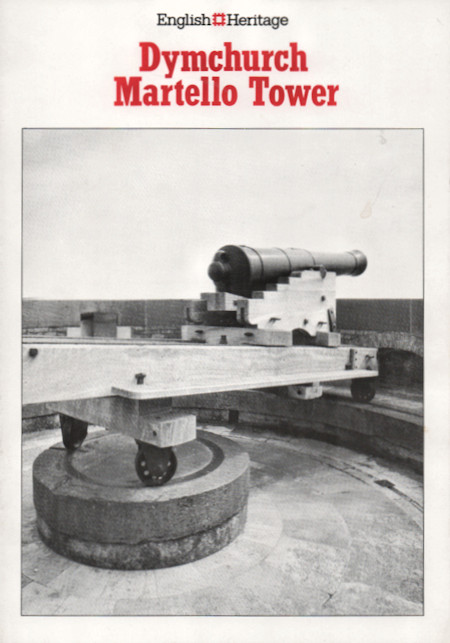
[Command+F on a Mac] and enter the subject/word you wish to find.
HISTORY
Dymchurch Martello Tower - no 24 in a chain of 74 built along the Channel coasts of Kent and East Sussex between 1805 and 1812 - was constructed to meet a threat of invasion as serious as the later one which faced England after the fall of France in the summer of 1940.
The Peace of Amiens, signed in March 1802, had ended nine years of war with Revolutionary France, but Napoleon's territorial ambitions in Europe and elsewhere were to ensure that peace was short-lived. On 18 May 1803, faced with clear evidence of France's expansionist aims and unwilling to tolerate Napoleon's control of Holland, England declared war.
For the first two years of the war, Napoleon's main aim was the invasion and subjugation of Great Britain. To that end, three army corps, all seasoned veterans of earlier campaigns, were ordered to the Pas de Calais and encamped on the coast between Calais and Étaples. To transport this Grand Army to England, Napoleon ordered the construction of an armada of flat-bottomed barges, to be supplemented by fishing boats and other small craft. Ambleteuse, Wimereux, Boulogne and Étaples were the principal construction and assembly ports for this vast fleet, but Calais, Dunkirk and Ostend played important supporting roles. Two years after the renewal of war, Napoleon had invasion shipping for almost 168,000 troops and equipment. `Let us be masters of the Straits for six hours' he had said in July 1804, adding modestly `and we shall be masters of the world'.
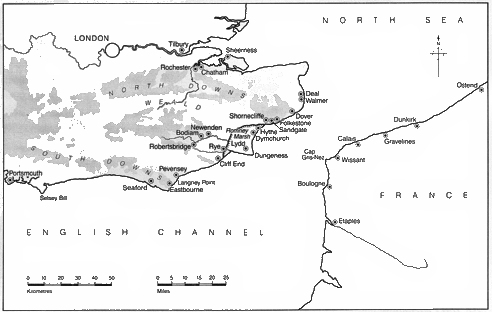
Channel coasts of England and France. The low-lying shores between Sandgate
and Eastbourne were considered the most threatened by French invasion
On land, Great Britain could not hope to match Napoleon's experienced professional troops. In 1803 the regular army stationed in England numbered only some 60,000 men; to this were added 50,000 militia and in 1804 about another 30,000 men forming the Army of Reserve. In addition, some 300,000 men flocked on the outbreak of the war to form the Volunteers, a part-time force of infantry and cavalry. The Volunteers were ill-equipped and lacked training and experience, but such deficiencies were counter-balanced to a certain extent by patriotic enthusiasm. Indeed, the very existence of the Volunteers is witness both to the unity of the country in 1803 and to a widespread feeling that a French invasion was all too probable.
The deployment of these troops called for careful judgement by the Commander-in-Chief, the Duke of York. London and the main naval arsenals - Chatham, Portsmouth and Plymouth - were obvious centres for defence, the naval towns fortunately comparatively well protected by permanent fortifications. However, it was realised that the best hope of stopping a French invasion was either to annihilate the invasion fleet at sea or to defeat the army at its beach head, preferably while it was still struggling ashore, but certainly before it could land its equipment and secure a port for artillery, reinforcements and supplies.
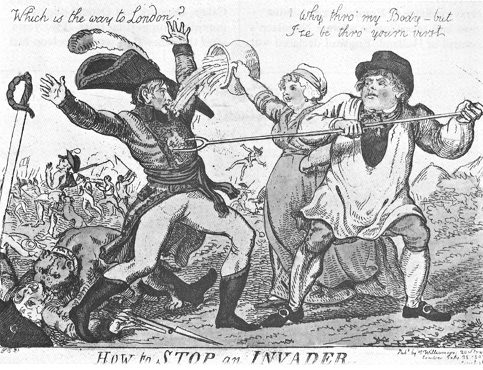
An 1803 cartoon depicting John Bull stopping the invader Napoleon with a pitchfork, whilst his wife
empties her chamber-pot over him. In the background, French troops flee in disorder
(HULTON PICTURE LIBRARY)
Napoleon's obvious invasion route was the shortest sea crossing. The transports being built and assembled were nor suitable for a voyage of more than about 24 hours, while the shorter the passage the less the troops were likely to he debilitated by sea-sickness. There was moreover, one over-riding and decisive factor favouring a quick crossing. French armies might be supreme in Europe but at sea it was the Royal Navy that exercised power. Almost alone, the Admiralty remained largely unperturbed by fears of invasion: in the House of Lords, St Vincent, First Lord of the Admiralty, sought to calm his fellow peers. `I do not say, my Lords,' he observed, `that the French will not come. I only say that they will not come by sea.'
St Vincent had reasonable cause for confidence. At the outbreak of war, the Royal Navy had around 640 fighting ships, including 177 of the larger ships-of-the-line; by January 1805, the total had risen to around 820.
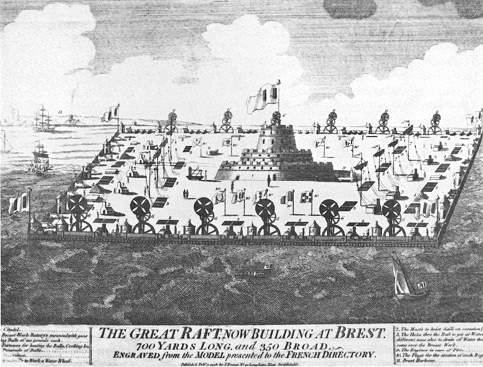
The imagination of artists knew no bounds! An English cartoon of 1798 purporting to show a monster raft being
built at the port of Brest in France, designed for transporting whole regiments of French troops to England
(HULTON PICTURE LIBRARY)
The Channel fleet, under Admiral Cornwallis, patrolled the western approaches and kept guard on French warships in Brest and Rochefort, while Admiral Lord Keith exercised a similar command east from Selsey Bill round into the grey waters of the North Sea. The Grand Army overlooking the Channel from its cliff-tops outside Boulogne, the shipwrights hard at work on the invasion flotillas from Ostend to Etaples and the French Army staff were all well aware of the weather-beaten cruising squadrons patrolling off-shore and of the power they represented. This disciplined use of maritime strength, exercised in all weathers, may have given much repair work to the English dockyards, but it ensured that the Royal Navy's training and seamanship were unrivalled.
But, despite the good British seamanship, there was always the possibility of a powerful French fleet escaping from Brest unnoticed, sailing up the Channel and securing the Straits just long enough to allow the French army to cross to England. Such an eventuality was outlined in a report from Lord Keith to the Duke of York, Commander-in-Chief of the army, in October 1803. Indeed, Lord Keith's assessment bore considerable similarities to Napoleon's later orders to Admiral Villeneuve in the Spring of 1805. By then, Napoleon had probably repented of his boast that France needed to secure the Straits for only six hours, for an army the size of his invasion force would have needed a minimum of three days just to embark and put to sea. None the less this risk of the French securing temporary mastery of the Straights led to increasing demands in England for better invasion defences.
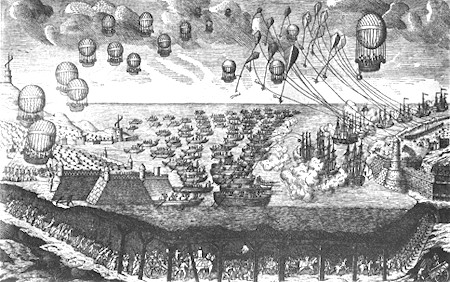
A French vision of the projected invasion, showing Napoleon's troops crossing the Straits of Dover by barge,
balloon and what must be the first Channel tunnel. In a further flight of fantasy, English soldiers,
suspended in the sky from kites, are shown firing their muskets at the invading balloons
(HULTON PICTURE LIBRARY)
Although British army planners could not be certain of Napoleon's exact choice of invasion beach, they could make reasonable deductions, knowing the geographic and estimating the logistic limitations within which the French general staff would have to work. An invasion fleet needed to land on shallow beaches adjacent to low ground; once ashore, the troops would have to capture a port to bring in heavy supplies such as an artillery train and would require access to rich countryside capable of feeding an army. Within the necessary short sailing-time from France, the low-lying beaches between Sandgate and Eastbourne seemed the most probable targets for an invasion, followed by a French encirclement of Dover and the capture of its vital harbour. Further to the north, the coasts of Essex and Suffolk, although suitable for an army intent on London, were felt to be less vulnerable if only because of their greater distance from France.
The British government, well aware of the strategic importance of this region of Kent and East Sussex, had been strengthening its defences since 1793. At Dover, among other works the medieval castle was modernised and given additional gun batteries and a vast fortress was started on Western Heights opposite it. These fortifications were not just to protect harbour and town; they could accommodate sufficient extra troops to oppose an invasion in the vicinity.
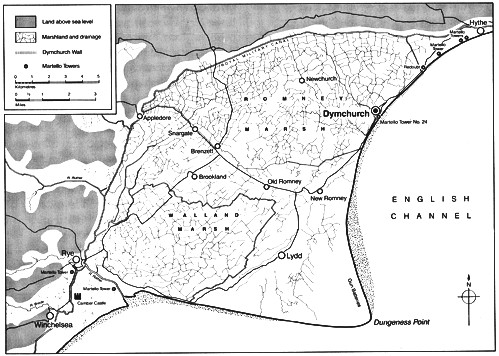
The low-lying coast between Hythe and Winchelsea. Much of the marshland
has been systematically drained. The Royal Military Canal was begun in 1804
The area of Romney Marsh, too, had received attention from military engineers. Schemes to flood it in the event of invasion were found to be impracticable, but by 1804 fifteen fortifications existed between Folkestone and Lydd, with those at Dungeness giving protection to ships anchoring on either side of Dungeness Point. Further west, the low-lying area of the Pevensey Levels was similarly protected by some 19 gun-batteries while, inland, river-crossings at places such as Newenden, Bodiam and Robertsbridge were guarded by small batteries. Most of these defences, though, were simple fieldworks. They were built of earth with timber or brick revetments and timber gun platforms and, while cheap to construct, they were in no sense permanent fortifications. They varied widely in size and power: Shorncliffe, the most substantial battery, mounted ten 24-pounder guns; in contrast, a sluice at Dymchurch was protected by a single 18-pounder weapon. How much of an obstacle they would have been against an assault by Napoleon's experienced troops was debatable.
Origins and Purpose of the Martellos
Soon after the renewal of war in the spring of 1803, Captain William Ford, one of the military engineers working on the Dover defences, put forward a proposal for a chain of square gun-towers - `towers as sea fortresses' - along the coasts of Kent and Sussex. These were to be sited at close intervals, so that their fire crossed for mutual protection, while the high cost of their construction compared to existing field-works was to be partly offset by their lower maintenance requirements. After some eighteen months of debate inside and outside the military establishment, Ford's proposals were adopted in modified form and the round towers then constructed became known as Martellos.
Circular fortified towers, used as strongholds or look-outs, had been built from prehistoric times, but in northern Europe, they had fallen from favour late in the fifteenth century after the invention of gunpowder and artillery had led to radical changes in the design of fortifications. Around the Mediterranean however, where piracy remained a problem long after it had been eliminated in northern waters, stone towers capable of limited defence continued to be built on the coasts where they also acted as look-outs and places of refuge. Nearer home, military engineers had recognised the defensive possibilities of such towers when they had constructed a number on the coasts of Jersey and Guernsey in the 1780s, while in 1796 a circular gun-tower was built at Simons Bay in Cape Colony, now part of South Africa. Three larger towers were erected at Halifax, Nova Scotia, in 1796-98 to protect British naval installations. All these towers, although principally designed and sited to withstand ship-mounted assaults, differed markedly in design and capabilities from the towers soon to be built in south-east England.
The strength of such towers had been dramatically demonstrated to the British in February 1794, when a fleet under Lord Hood had been sent to capture Corsica. Crucial to the British attack was the capture of a stone watch-tower on Mortella Point. This tower was armed with one 6-pounder and two 18-pounder guns by the French and it successfully repulsed an attack by HMS Fortitude (74 guns) and HMS Juno (32 guns), both of which withdrew with serious damage and some sixty casualties. The army then built a four-gun battery some 150 yards from the tower and after two days of continuous bombardment forced the garrison to surrender. Not surprisingly, the resistance of this tower made a deep impression on the attackers; drawings and sketches were made of it, and before its demolition prior to the British withdrawal from Corsica in the autumn of 1796, a scale model was constructed which can be seen at the Royal Artillery Museum at Woolwich. No doubt mindful of the strength of the Mortella tower, the British repaired and augmented by fifteen a chain of similar towers in 1798 when they re-occupied Minorca for the third time in the eighteenth century.
It is clear that these Mediterranean towers excited the attention of English military engineers of the day. For generations, they had been schooled to dismiss the defensive properties of tall and apparently vulnerable towers and to design fortifications offering the minimum of target to an enemy; yet the Mortella Point action clearly showed that in certain circumstances well-built gun-towers had an important role. In putting forward his proposal for a chain of such towers on the Kent and Sussex coast, Captain Ford was no doubt articulating ideas current among his military colleagues. When the English towers came to be built, their name was derived from the Mortella Point tower.
The reasoning was simple: the Mortella tower had successfully driven off two heavily-armed warships. British towers would be able to do the same and would be even more devastating against lightly-built and largely unarmed invasion barges. A chain of towers within gun-shot of each other would be mutually protective and would offer formidable defence against a French invasion force. Even if the French were able to land artillery and subdue a number of towers, the resultant delay would provide vital time for the main British forces to concentrate and to contain the enemy.
Ford's scheme, submitted to his senior officer Brigadier General William Twiss, commanding officer for the southern district, was passed to the Master of Ordnance and eventually to the Committee of Royal Engineers tasked to evaluate such schemes. Opinion was generally in favour of the idea but differed sharply on the number and design of the towers. Ford's square tower was abandoned in favour of a round one and for reasons of cost, many favoured using the towers to guard only the most vulnerable beaches, protect marshland sluices and to supplement existing fortifications.
In May 1804 William Pitt replaced Addington as Prime Minister; Pitt was known to be interested in coastal defences and it is probably no coincidence that within a few months of his taking office, Twiss was sent to survey the coast between Beachy Head and Dover to select sites for a chain of towers.
Twiss submitted his report in early September, recommending 58 towers to protect vulnerable beaches, Rye Harbour and the Romney Marsh sluices. At Sandgate, Henry VIII's castle was to be modernised and re-equipped. Armed with this report, but faced with conflicting views on the design, spacing and even the need for such fortifications the Privy Council ordered a conference to be held at Rochester on 21 October 1804 to discuss the whole question of coastal defence. While this debate was in progress - and proving that the government could act with remarkable speed if necessary - Lt Col John Brown submitted a plan for a defensive canal from Hythe to the river Rother to isolate Romney Marsh from the high ground to the rear; a western extension from the River Brede to Cliff End was to cut off Pett Level and Winchelsea Beach.
Three substantial military advantages were seen for such a canal: it formed a physical barrier sundering the marshland from the rest of the country; it avoided the need to inundate the marshland with all the attendant damage to property, grazing land and livestock, and barges on it would provide rapid transport for troops. Brown's report went to the Commander-in-Chief on 18 September; eight days later Pitt authorised construction of the Royal Military Canal.
Building the Martello Towers, 1805-12
In October 1804 the Rochester Conference supported the concept of vaulted bomb-proof artillery towers as the best and most effective means of coastal protection but recommended circular towers as cheaper than the square ones proposed originally by Ford. Eighty-three of these towers were advocated, together with the modernisation of Sandgate Castle and the construction of two much larger circular forts or redoubts. One of these was to be sited at Eastbourne, the other was to guard Rye Old Harbour. In the event, the latter was sited at the eastern end of Dymchurch sea-wall.
Work on the chain of towers began in the spring of 1805 under the direction of the Board of Ordnance and the Royal Engineers. A large proportion of the huge quantity of bricks required was shipped down the Thames from the London brickfields. The main contractor was a William Hobson, who sub-contracted work to local builders. When work on the South Coast chain stopped in 1808 there were 73 towers and two eleven-gun circular forts. Work then began on a similar chain of 29 towers along the coasts of Essex and Suffolk, with a circular redoubt at Harwich, while a further tower was added at Seaford in Sussex before construction finally ended in 1812.
Tower no 24 at Dymchurch was one of twenty-one towers guarding the coastline of Romney Marsh between Hythe in Kent and Rye in Sussex. The eastern area of the marsh was protected from the sea then, as now, by the massive three-mile-long bank or dyke known as the Dymchurch Wall. Possibly Roman in origin, this bank has been strengthened and enlarged over the centuries as part of an unceasing battle to prevent the sea inundating the rich marshland.
At Dymchurch, the old centre for the administration of Romney Marsh, three of the principal marshland drains emptied into the sea at low tide through sluices. To protect these outfalls Twiss sited three pairs of towers. Nos 22 (demolished) and 23 guarded Willop Sluice to the east, nos 24 and 25 defended the main Marshland Sluice, while 26 and 27, both demolished in the nineteenth century, protected Globsden Gut sluice to the west.

Bust of William Hobson who built many
of the South Coast Martello Towers
In 1803 Parliament had passed an Act, amended the following year, enabling the government to acquire by purchase land needed for defence and security of the realm. Armed with powers from this Act, Twiss and his colleagues negotiated sites for the towers direct with the various landowners. The land for tower no 24 was owned by the Dering family of Surrenden Dering in the Kent parish of Pluckley; Sir Edward Cholmeley Dering was then a minor and it was not until 1813 that the Treasury Solicitors - like many lawyers, not noted for speed - completed the legal negotiations with Sir Edward's guardians. The guardians discharged their duty well: the site of just over an acre was sold to the government for the substantial sum of £235. By then, tower no 24 had been built for some five years.
Design of the South Coast Towers
The South Coast towers were all of identical design, any slight variations in measurements being due probably to different builders. Although superficially circular, they are elliptical in plan with the inner and outer circles of the tower walls arranged eccentrically so that the thickest part of the wall faces seawards. The towers are some 33 ft (10 m) tall and tapered so that on the seaward side the walls vary in thickness from 13 ft (4m) at the base to 6 ft (1.8 m) at parapet level. To increase their ability to withstand bombardment, the bricks were bedded in hot lime mortar - a mixture of lime, ash and hot tallow. The towers were numbered in sequence from east to west; in contrast, the East Anglian chain was given letters.
Entrance to the towers was at first-floor level. This floor was divided by timber partitions to form living-quarters for the garrison of 24 men and one officer. The floor was lit by two small windows overlooking the rear or landward side. The unlit ground floor, approached by an internal ladder, contained space for stores and ammunition. The flat roof, which formed the gun platform inside the thick parapet, was carried on a circular brick vault supported by a central column from the base of the tower. The roof was gained from the first floor by a stair contrived in the thickness of the Wall. The great breadth of the walls also allowed space, for ventilation shafts and chimney flues which emerged in the thickness of the parapet.
The main armament of a Martello was a 24-pounder gun mounted on a carriage capable of traversing 360 degrees; in addition, those Martellos on high ground at the eastern end of the chain were provided with 5½-inch howitzers. The garrison was also equipped with muskets. An 1818 survey, when most of the armament was being removed for storage at the Tower of London, records that each tower then had the following stock of ammunition: 100 rounds of solid shot, 20 case-shot, 20 grape-shot, 20 common shells, 20 8-lb powder cartridges, ½cwt (25 kg) of slow match and 40 junk wads. Those towers with howitzers had proportionately more ammunition for the extra weapon.
Providing troops to man all these new defences taxed the Board of Ordnance, which was responsible for the field artillery as well as permanent fortifications. Hitherto, the extra men needed to man guns in fortifications on the outbreak of war had been found from the fleet, infantry garrisons, or county militia regiments. By 1803 such men could not be spared. Fencibles - volunteer units of the regular army limited to home defence - were in similar short supply; while the Admiralty was most reluctant to transfer any of its Sea Fencibles - a force raised by the Royal Navy in 1797 from fishermen and coastal seamen and used to man gun-boats and armed vessels guarding coastal waters and anchorages.
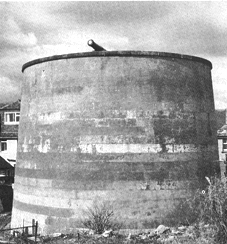
Dymchurch Martello Tower. The thick walls were designed
to withstand heavy bombardment from the sea
The official solution was to use Artillery Volunteers, normally recruited in the neighbourhood, strengthened with a number of trained men from the Royal Artillery. The bulk of these Artillery Volunteers were to be found operating guns in the great fortress towns such as Sheerness, Dover, Portsmouth and Plymouth, but it seems that small detachments were the normal means of manning the chains of Martello towers.
By the time the towers were complete, the threat of invasion had all but vanished. As no Martello ever fired a shot in anger, their effectiveness was never tested. Nevertheless, there is little doubt that with properly trained garrisons and adequate supplies in their basements they could have been formidable. The towers themselves were impregnable to troops without heavy siege-guns, while each tower was within the protective range of at least one neighbouring tower. Firing solid shot, the 24-pounder guns could have caused immense damage to the lightly-built invasion craft as they neared the shore. If the French forces had reached the beaches, such heavy shot was even more lethal to dense masses of troops - there are records from battles elsewhere of up to 40 men being killed by a single shot at a range of 600-800 yd (549-732 m). To kill enemy troops within about 350 yd (320m) range, the Martello gunners would have started to fire case-shot, which could be either `heavy' or `light'. The former consisted of 84 6oz balls contained in a thin metal cannister, the latter of 232 2oz balls similarly packed. When fired, the cannisters burst, spraying a deadly hail of bullets. A single round of heavy case-shot was almost as lethal as a volley of musket-shot from an infantry company of 100 men and an efficient gun's crew would be expected to maintain a firing-rate of three cannisters a minute, although perhaps for only a comparatively short time. Given such opposition, even the pick of Napoleon's troops might have faltered.
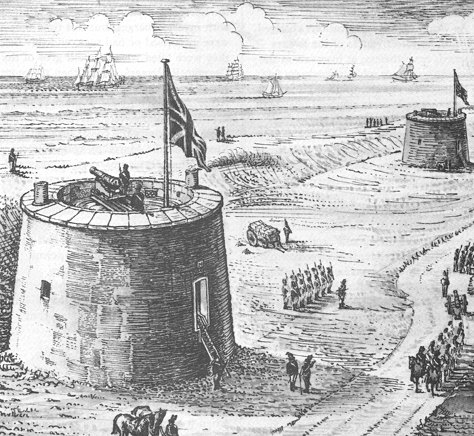
Artist's impression of two garrisoned Martello Towers on the Kent coast
When peace was finally restored after the Battle of Waterloo in 1.815, coastal defence garrisons were speedily reduced from their wartime strengths. The Martellos were put to a variety of uses, many simply becoming homes for retired soldiers. Some, however, found more active roles. As early as 1812 the towers were used to relay simple messages between Seaford and Lympne by means of a Union Jack and various combinations of three back canvas balls hoisted on a flag pole on the roof of each.
After the war, four were equipped with semaphore apparatus. The majority of the towers found a new role in the war against smuggling; as late as 1850 coastguards occupied twenty-eight of the towers.
Although the South Coast Martellos are the best known, military engineers employed variants of the design elsewhere, Over fifty were built in Ireland and between 1808 and 1846 a further thirteen were constructed in British North America. In some cases, these Canadian towers were exclusively for land defence, a very different role from the ship-shore function they had been designed originally to fulfil.
As weapons and fortifications changed, the military effectiveness of the towers lessened: nevertheless, at intervals in the nineteenth century when there were felt to be invasion threats, the Kent and Sussex towers became renewed objects of attention from the military and in some cases were repaired and re-armed. The most sustained campaign was probably in the early 1850s at a time when there was widespread suspicion of France and when limited sums were being spent modernising fortifications at Dover and around Portsmouth. Then contractors tendered for repairing and re-arming most of the Martellos, though it is doubtful if this work was ever completed.
By the 1870s the smooth-bore muzzle-loading gun, firing a solid shot, had been made wholly obsolete in Europe as a result of revolutionary developments in ordnance design which began in the 1850s. The demise of the cast-iron muzzle-loading gun, the mainstay of armies and navies since the sixteenth century, spelt the end of the Martellos as a serious defence. In the ensuing decades, a number were sold, some were converted to houses and others were demolished or destroyed by the sea. The coastguards continued into the twentieth century to use a number as convenient look-outs, including tower no 24 at Dymchurch.
Then in 1940 history repeated itself. With the evacuation of the British Expeditionary Force from Dunkirk in late May and early June 1940, the Kent and Sussex Martello chain once again was in the front line on a coast where invasion was daily expected. Once more, the northern French ports began to fill with invasion barges, but this time they were motorised or had tugs, and this time they were filled with the field-grey of the German Wehrmacht rather than the more gaudy uniforms of Napoleon's Grand Army. Throughout the summer of 1940, invasion defences were hurriedly improvised along the coasts of Kent and Sussex and the Martellos again found a use. Some became observation posts and had concrete roofs added as protection against air-attack, others were used by the Home Guard and the army. The original gun platforms were too exposed for modern warfare, but a few had their first-floor windows altered to permit the mounting of light machine-guns.
Since 1945 the number of Martellos has continued to decline. Of the original 74, only 25 remained by 1986 and of these perhaps only nine survive unaltered. By the late 1950s, an appreciation of the importance of Martellos in the history of English defences led the Ministry of Works to acquire tower no 24 from the War Office when it became surplus to coastguard requirements. It was restored and opened to visitors in 1969 and is now in the care of English Heritage. More recently, tower no 73 has been opened by Eastbourne Museum, which has also carried out a remarkable renovation of the nearby contemporary redoubt. Only tower no 66 at Langney Point near Eastbourne preserves a direct link with nineteenth century use, for it remains the sole Martello still occupied by the coastguards.
Description of Dymchurch Martello Tower No 24
The majority of Martellos were built on comparatively lonely and remote areas of the coast; in contrast no 24 and its immediate neighbours at Dymchurch had to be fitted in among the existing cottages and gardens of the village.
The only access to the tower is through the first-floor doorway, placed there for defensive reasons. The stairs are modern; originally there would have been a ladder, taken up as necessary and stored within the tower. The chamfered stone guide for the ladder can be seen beneath the modern landing.
All Martellos had just three levels: the fighting platform on the roof, the first floor where the garrison lived and the basement used for storage of ammunition and supplies. When the Ministry of Works acquired the tower in 1959, most of the timber work was rotten and had to be replaced. However, sufficient partitions remained here and in the adjacent tower no 23 to allow accurate restoration.
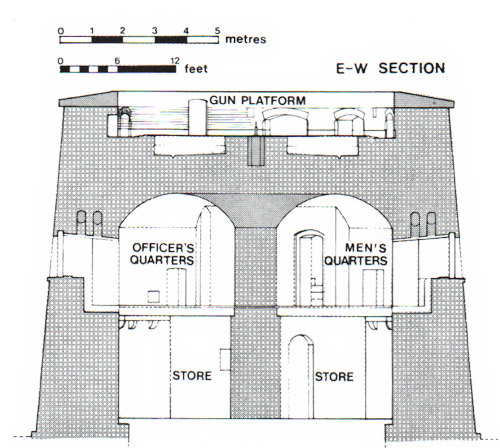
E-W Section of Martello Tower No.24
It is possible that the design of these partitions and their positions reflect refurbishment works for which tenders were submitted in 1853, but, if so, it is unlikely that they differ significantly from the 1804 layout.
Inside the entrance is a vestibule with a trap-door to the basement; above the trap a metal ring in the vault was used for a rope for hauling stores up from below. Immediately in front of the entrance is the central brick column supporting the vault; around the column is a rack that once held flintlock muskets, main weapon of the British army from the 1730s to the 1830s.
The muskets here would probably have been the cheaper `India Pattern' type, made in large numbers by the Last India Company for its own armies, but purchased by the Board of Ordnance to supplement its own production and purchases of the famous Brown Bess muskets. The latter were reserved for British regular troops.
To the left of the entrance, now used by the custodian, is a small room which was once a store-room. Beyond it was the room used by the officer in charge of the Martello; this had its own window and fireplace. The circular vents above the window lead up to the parapet and were designed to dissipate musket smoke in times of siege. The remaining space on this floor was allocated to the 24-man garrison.
The one-room forming the garrison quarters has a window and fireplace, while on the southern side a staircase in the thickness of the wall leads to the roof. The total floor area allocated to the 24 men was only marginally larger than that for their commanding officer, eloquent testimony to the privileges of rank in the Georgian army.
In these rooms is a small exhibition on Martello towers, together with a bust of William Hobson, the principal building contractor.
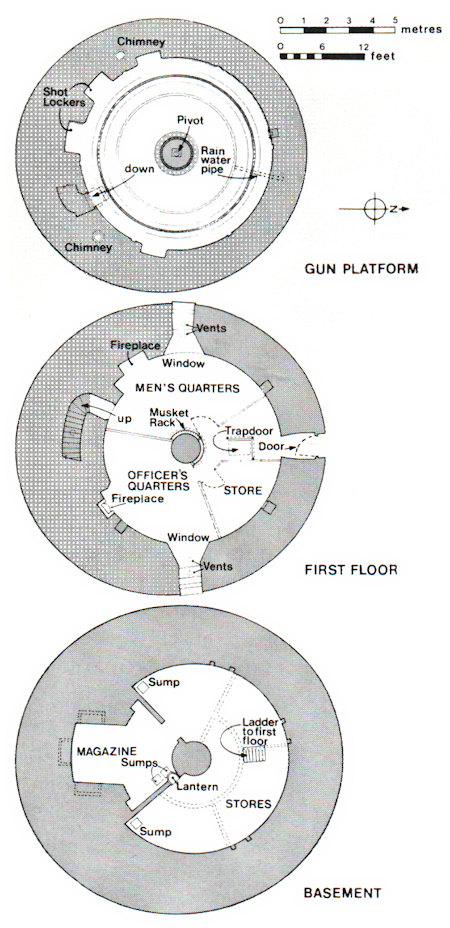
Floor Plans
The basement is now approached by a steep staircase below the trapdoor. Down here the area was devoted to storage of garrison provisions and ammunition. On the south side, partly recessed into the thickness of the outer wall and with its own brick vault, is the gunpowder magazine.
To keep the powder dry, the walls were built double-skinned with narrow ventilation slits. To avoid the danger of an explosion from sparks, the powder magazine was lit by a lantern separated from the magazine by glass. Within the magazine are displayed modern replicas of the powder barrels; each barrel held 100 pounds of gunpowder. The cannon balls would have been stored in the main area of the basement.
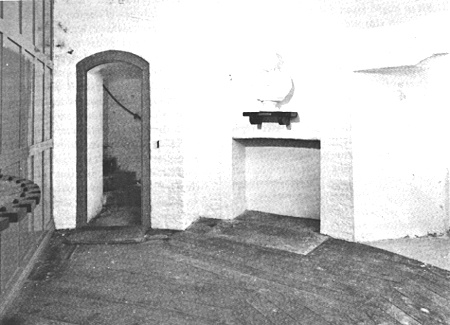
Men's Quarters on First Floor, with on the left , a
mucset-rack and the stairs to the gun patform above
At intervals in the floor of the basement can be seen drainage sumps. Originally these would have been covered by a timber floor. When properly stored and provisioned, this area of the Martello would have been full of barrels of various sizes containing water, salt beef, butter, cheese, bread and other foods, while wooden bins would have held coal for the fires.
Given the close proximity of the village of Dymchurch, it may be doubted whether this and the neighbouring Martellos in practice ever kept much in the way of provisions, for the garrisons undoubtedly would have preferred to buy fresh produce locally.
The absence of any permanent latrines in the towers would suggest that, in times of siege, elementary sanitary facilities would have had to be provided down here as well.
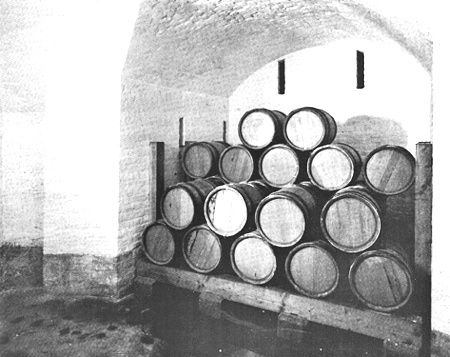
Basement where provisions and ammunition were stored
The gun platform is reached by the stair from the first floor. This stair was carefully positioned in the thickest part of the tower wall and like the windows has vents in its vaulted roof to disperse gun smoke. The door at the top similarly has a circular hole near its base. The gun platform is dominated by the 24 pounder gun on its traversing carriage which enabled the weapon to fire in any direction; the gun barrel is the original one supplied to this tower. The letters WC cast into its trunnion or pivot identify it as a product of the famous gun founding firm of Samuel Walker & Co. This firm was established in 1741 at Grenoside near Sheffield but moved to Rotherham in 1746 and from the 1770s became one of the principal suppliers to the Board of Ordnance.
On top of the barrel is the cipher of George III and to the rear is the touch hole. Degrees of elevation and depression to guide the gunlayer are incised on the base ring.
The traversing carriage is an accurate modern replica made in the Totnes gun workshop of English Heritage. It could be turned through 360 degrees with the aid of ropes threaded through the iron rings set in the wall of the parapet. Operating the gun required a detachment of ten to fourteen men; it had an effective range of approximately one mile.
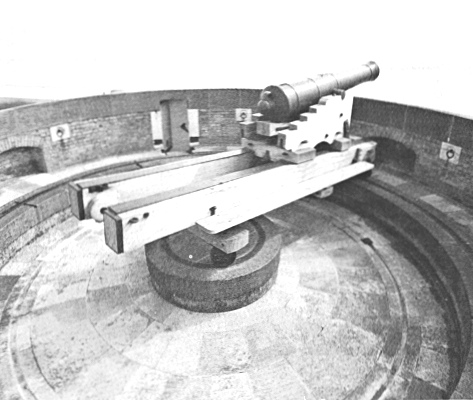
Roof-top gun platform. The trversing carriage could be turned by ropes threaded through the iron rings. The parapet gave the gunners protection from enemy fire.
The four recesses in the parapet wall were to store ammunition for immediate use; further supplies would have been passed up from the basement. Rainwater from the gun platform was piped into the sumps below the basement to supplement garrison supplies. To the west can be seen tower no 25, its partner guarding the sluice. Although the village of Dymchurch still has a number of old buildings, those adjacent to the tower no 24 are of more recent date. However, the terrace of houses immediately to the east of the tower is a link with its later use. On its front the stone plaque with the fouled anchor and the date 1905 shows that it was built as coastguard cottages by the Admiralty, responsible for the coastguard service from 1856 to 1923.
P BLOOMFIELD, `Kent and the Napoleonic Wars', Kentish Sources, X. Maidstone, 1987
J G LOAD, The Royal Dockyards 16901850. Aldershot, 1989
J G LOAD AND P N LEWIS, `The Later Fortifications of Dover', Post-Medieval Archaeology, 16, 1982
R GLOVER, Britain at Bay. Defence against Bonaparte 1803-1814. London, 1973
K W MAURICE-JONES, The History of Coast Artillery in the British Army. London, 1959
ANDREW SAUNDERS, Fortress Britain. Liphook, 1989
IVAN J SAUNDERS, A History of Martello Towers in the Defence of British North America, 1796-1871. Ottawa, 1976
S SUTCLIFFE, Martello Towers. Newton Abbot, 1972
P A L VINE, The Royal Military Canal. Newton Abbot, 1972
In the Public Record Office, Kew, the WO; 55 series of documents contains some accounts of the building.
Case-shot Numerous small metal balls packed into cannister that bursts when fired from a muzzle-loading gun. Used as anti-personnel weapon
Chamfer Surface produced by bevelling the intersection of two planes
Fencibles Volunteer force first raised in 1794 by the War Office for home service (including Ireland) and paid on a regular basis
Flint-lock Mechanism on musket in which a spark from a flint ignites the priming powder and fires the weapon
Grape-shot Shell-shaped projectile, formed by packing small iron shot around a spindle on a plate in a canvas bag. Effective up to 600 yd, a greater range than the lighter case-shot. Used against ships' rigging, as well as anti-personnel
Howitzer Light gun which fired a heavy projectile with considerable accuracy at a high angle of elevation
Junk Wad Rope wad which was inserted into muzzle-loading gun between the gun-powder and the shot
Musket Standard smooth-bore hand-gun used by armies, until made obsolete by the introduction of the rifle in the nineteenth century Pounder Definition of the power of a muzzle-loading gun by the weight of the shot fired
Redoubt A detached defensive outwork
Sea Fencibles Home-based seamen who guarded coastal waters and anchorages
Shot Non-explosive solid projectile fired from muzzle-loading gun
Slow Match Rope fuse which was slow burning


















